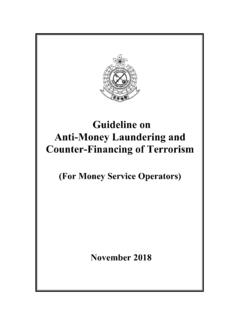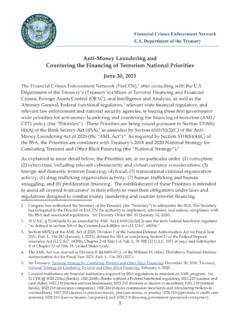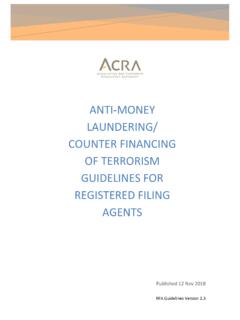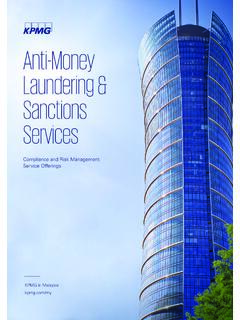Transcription of Handbook on Anti-Money Laundering and Combating the ...
1 ASIAN DEVELOPMENT BANKHANDBOOK ONANTI- money Laundering AND Combating THEFINANCING OF TERRORISMfor Nonbank Financial InstitutionsHANDBOOK ONANTI- money Laundering AND Combating THEFINANCING OF TERRORISMfor Nonbank Financial InstitutionsASIAN DEVELOPMENT BANK 2017 Asian Development Bank6 ADB Avenue, Mandaluyong City, 1550 Metro Manila, PhilippinesTel +63 2 632 4444; Fax +63 2 636 rights reserved. Published in in the 978-92-9257-761-2 (Print), 978-92-9257-762-9 (e-ISBN)Publication Stock No. TIM168550 DataAsian Development Bank. Handbook on Anti-Money Laundering and Combating the financing of terrorism for nonbank financial City, Philippines: Asian Development Bank, Anti-Money Laundering . 2. Combating the financing of terrorism . I. Asian Development views expressed in this publication are those of the authors and do not necessarily reflect the views and policies of the Asian Development Bank (ADB) or its Board of Governors or the governments they represent.
2 ADB does not guarantee the accuracy of the data included in this publication and accepts no responsibility for any consequence of their use. The mention of specific companies or products of manufacturers does not imply that they are endorsed or recommended by ADB in preference to others of a similar nature that are not making any designation of or reference to a particular territory or geographic area, or by using the term country in this document, ADB does not intend to make any judgments as to the legal or other status of any territory or work is available under the Creative Commons Attribution IGO license (CC BY IGO) By using the content of this publication, you agree to be bound by the terms of this CC license does not apply to non-ADB copyright materials in this publication. If the material is attributed to another source, please contact the copyright owner or publisher of that source for permission to reproduce it.
3 ADB cannot be held liable for any claims that arise as a result of your use of the You should always acknowledge ADB as the source using the following format:[Author]. [Year of publication]. [Title of the work in italics]. [City of publication]: [Publisher]. ADB. [URL or DOI] [license].Translations Any translations you create should carry the following disclaimer:Originally published by ADB in English under the title [title in italics]. ADB. [URL or DOI] [license]. The quality of the translation and its coherence with the original text is the sole responsibility of the translator. The English original of this work is the only official Any adaptations you create should carry the following disclaimer:This is an adaptation of an original work titled [title in italics]. ADB. [URL or DOI][license].
4 The views expressed here are those of the authors and do not necessarily reflect the views and policies of ADB or its Board of Governors or the governments they represent. ADB does not endorse this work or guarantee the accuracy of the data included in this publication and accepts no responsibility for any consequence of their contact if you have questions or comments with respect to content, or if you wish to obtain copyright permission for your intended use that does not fall within these terms, or for permission to use the ADB : Figures, tables, and boxes without explicit sources are those of to ADB publications may be found at Commons Attribution IGO license (CC BY IGO) iiiiiiContentsForeword ivAbbreviations vOverview 1 Part A.
5 Policies and Standards 7 Roles and Responsibilities 9 Policy Statement 10 Customer Acceptance Policy 11 Independent Audit and Review 12 Risk-Based Approach to Managing Risk 13 Awareness Raising and Training of the Staff 23 Part B: Procedures 27 Customer Due Diligence Requirements 29 Requirements for Establishing a Relationship or Opening an Account 31 Reviewing Customer Due Diligence Information and Monitoring Customer Accounts 42 Recognizing Suspicious Activity 46 Record Keeping 49 Glossary 51 Appendixes1 Responsibilities and Roles of Directors and Senior Management 532 Responsibilities and Roles of the Compliance Officer 553 Responsibilities and Roles of the Management 574 Responsibilities and Roles of the Staff 585 Example of a Risk Assessment Form 596 Example of an Account Opening Checklist Individuals 627 Example of an Account Opening Checklist Businesses 648 Examples of Suspicious
6 Transactions 659 Web References 84 References 87ivForewordNonbank financial institutions (NBFIs) serve as a viable option to banks by providing financial services to boost economic activity. They have expanded rapidly since the 2008/09 global financial crisis. Given the growing importance of NBFIs in facilitating access to finance and financial services, it becomes increasingly imperative for them to comply with Anti-Money Laundering and Combating the financing of terrorism (AML/CFT) requirements to avoid abuse by criminals or those involved in the financing of Asian Development Bank (ADB), through its Office of Anticorruption and Integrity (OAI), has recognized the challenges facing NBFIs in meeting national and international AML/CFT requirements.
7 Accordingly, ADB decided to develop a technical assistance project designed to develop AML/CFT approaches, methodologies, and controls for NBFIs. This Handbook was developed under the auspices of the technical assistance commissioned by OAI. The purpose of the Handbook is to assist NBFIs in developing and implementing internal policies, procedures, and controls, as well as to provide guidance on practical issues to manage the risks of being exposed to money Laundering and the financing of publication reflects the requirements of the international standard setter, the Financial Action Task Force, in the fight against money Laundering and terrorist financing . Controls, policies, and procedures that should be implemented by individual NBFIs need to (i) reflect the requirements in their jurisdiction and (ii) be consistent with best practice and the NBFI s nature and scope of hopes this Handbook will be useful in your efforts to ensure that your institution is not used to launder the proceeds of crime or to finance WeeHeadOffice of Anticorruption and IntegrityAsian Development BankPolicies and StandardsvAbbreviationsAML Anti-Money launderingCDD customer due diligenceCFT Combating the financing of terrorismFATF Financial Action Task ForceNBFI nonbank financial institutionPEP politically exposed person1 OverviewThis Handbook provides guidance to nonbank financial institutions (NBFIs)
8 On how to manage risks related to money Laundering and the financing of terrorism . It comprises two parts. Part A outlines policies and standards that should be adopted by NBFIs and that reflect the international requirements of the Financial Action Task Force. Part B includes guidance on procedures that need to be implemented to ensure compliance with these requirements and those of the country s Handbook also serves as the basis for staff training. How to use this handbookThis Handbook is intended to assist NBFIs in developing and implementing policies and procedures to combat money Laundering and the financing of terrorism . The Handbook provides general guidance on key Anti-Money Laundering and Combating the financing of terrorism (AML/CFT) requirements. Information contained in the Handbook should be adapted to reflect the nature of activities, products, and services offered by individual NBFIs as there is no one size fits all approach to the management of risk.
9 Topics covered include information on the following: What is money Laundering and terrorist financing ? Why are NBFIs required to implement AML/CFT policies and procedures? The roles and responsibilities of senior management and staff of NBFIs The need to identify and understand risks The need to train staff Customer due diligence requirements Suspicious transaction identification and reporting Record-keeping obligationsHandbook on Anti-Money Laundering and Combating the financing of Terrorism2 The Handbook includes examples of account opening forms and other information that may assist NBFIs in implementing effective AML/CFT risk management systems and are NBFIs covered by AML/CFT requirements?NBFIs provide a range of financial services to their customers, which include the acceptance of deposits or other repayable funds from customers; lending; money or value transfer services; issuing and managing means of payment ( , credit and debit cards, checks, traveler s checks, money orders, and electronic money ); and money and currency financial services are subject to laws that deal with AML/CFT.
10 These laws impose a range of requirements on NBFIs and these are outlined in this should NBFIs do to comply with AML/CFT requirements?To comply with government legislation,1 NBFIs must develop policies and procedures which will enable them to identify risks related to money Laundering and terrorist financing and put in place controls to manage these risks, including the reporting of suspicious transactions to appropriate authorities. The policies and procedures which should be put in place include the following requirements: Assessing and understanding the risks arising from doing business Know your customer and customer due diligence (CDD) Monitoring transactions Reporting suspicious transactions Record keepingIf the government has approved legislation for tackling AML/CFT in its jurisdiction, the enforcement will be the responsibility of the supervisory authority and the financial intelligence Subject to a country s own is money Laundering and terrorism financing ?
















